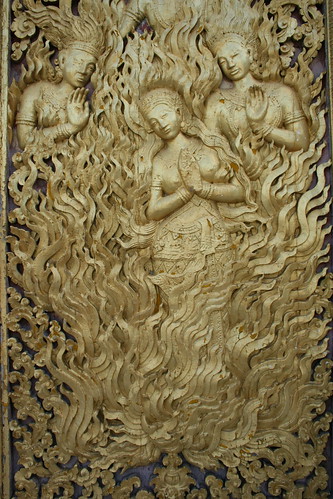Carved temple door in Laos.
Laos (pronounced /ˈlɑːoʊs/ or /ˈlaʊs/), officially the Lao People's Democratic Republic, is a landlocked country in southeast Asia, bordered by Burma (Myanmar) and China to the northwest, Vietnam to the east, Cambodia to the south, and Thailand to the west. Laos traces its history to the Kingdom of Lan Xang or Land of a Million Elephants, which existed from the fourteenth to the eighteenth century. After a period as a French protectorate, it gained independence in 1949. A long civil war ended officially when the communist Pathet Lao movement came to power in 1975 but the protesting between factions continued for several years.
Theravada Buddhism is a dominant influence in Lao culture. It is reflected throughout the country from language to the temple and in art, literature, performing arts, etc. Many elements of Lao culture predate Buddhism, however. For example, Laotian music is dominated by its national instrument, the khaen, a type of bamboo pipe that has prehistoric origins. The khaen traditionally accompanied the singer in lam, the dominant style of folk music. Among the various lam styles, the lam saravane is probably the most popular.
The country has two World Heritage Sites: Luang Prabang and Vat Phou. The government is seeking the same status for the Plain of Jars.
The People's Republic of China has recently allowed its citizens to travel more freely to Laos[citation needed]. As such, Chinese tourists are expected to account for 25% of the total number of visitors to Laos (up from only a few percent) in 2006. Pressures to modernize tourist infrastructure, particularly to cater to package tourism, are expected to significantly impact Luang Prabang and other culturally important Laotian cities. The people of Laos have a reputation for being very kind and welcoming to all visitors.














No hay comentarios:
Publicar un comentario